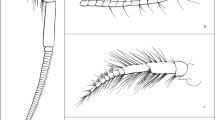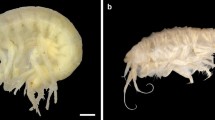Abstract
The structure of olfactory sensilla was compared in amphipods from the Baikal region, namely in nine Baikal species (Ommatogammarus carneolus melanophthalmus Bazikalova, 1945; O. flavus (Dybowsky, 1874); O. albinus (Dybowsky, 1874); Eulimnogammarus verrucosus (Gerstfeldt, 1858); E. vittatus (Dybowsky, 1874); E. cyaneus (Dybowsky, 1874); Acanthogammarus godlewskii (Dybowsky, 1874); Pallasea cancelloides (Gerstfeldt, 1858); and Gmelinoides fasciatus (Stebbing, 1899)) and a Holarctic species, Gammarus lacustris Sars, 1863. The results of the study demonstrate the comparison of aesthetasc lengths and numbers, as well as SEM images of the aesthetascs for Baikal amphipods for the first time. Our results confirm and complement the previously obtained data on the number of aesthetascs per segment for three deep-water Baikal amphipod species of the genus Ommatogammarus. Within the studied deep-water amphipods with different habitat depth ranges, Ommatogammarus albinus (Dybowsky, 1874), inhabiting maximum habitat depths, have the highest number of aesthetascs. The size and number of aesthetascs did not differ between males and females of the littoral Eulimnogammarus verrucosus (Gerstfeldt, 1858) and deep-water species. The littoral amphipods were shown to have more antennae I equipped with mechanoreceptors than deep-water amphipods.






Similar content being viewed by others
REFERENCES
Arfianti, T., Biodiversity and biogeography of Amphipod Crustaceans, Doctoral Dissertation, Auckland: ResearchSpace, 2020. https://researchspace.auckland.ac.nz/handle/2292/53402.
Bazikalova, A.Ya., Lake Baikal amphipods, Tr. Baik. Limnol. Stn., 1945, vol. 11, p. 1.
Bedulina, D.S., Shatilina, Zh.M., and Gurkov, A.N., Physi-ological and biochemical markers of stress response of endemic amphipods from Lake Baikal: Current state and perspectives, Izv. Irkutsk. Gos. Univ., Ser.: Biol. Ekol., 2018, vol. 23, p. 3.
Breithaupt, T. and Thiel, M., Chemical Communication in Crustaceans, New York: Springer Science and Business Media, 2011.
Derby, C. and Thiel, M., The Natural History of the Crustacea, vol. 3: Nervous systems and control of behavior, Oxford Univ., 2014.
Derby, C.D., Kozma, M.T., Senatore, A., and Schmidt, M., Molecular mechanisms of reception and perireception in crustacean chemoreception: a comparative review, Chem. Senses, 2016, vol. 41, no. 5, p. 381. https://doi.org/10.1093/chemse/bjw057
Gurkov, A., Rivarola-Duarte, L., Bedulina, D., et al., Indication of ongoing amphipod speciation in Lake Baikal by genetic structures within endemic species, BMC Evol. Biol., 2019, vol. 19, p. 1. https://doi.org/10.1186/s12862-019-1470-8
Hallberg, E., Johansson, K.U.I., and Elofsson, R., The aesthetasc concept: structural vatiations of putative olfactory receptor cell complexes in Crustacea, Microsc. Res. Tech., 1992, vol. 22, no. 4, p. 325. https://doi.org/10.1002/jemt.1070220403
Jamieson, A.J., Fujii, T., Mayor, D.J., et al., Hadal trenches: the ecology of the deepest places on Earth, Trends Ecol. Evol., 2010, vol. 25, no. 3, p. 190. https://doi.org/10.1016/j.tree.2009.09.009
Jaume, D., Cartes, J.E., and Sorbe, J.C., A new species of Bathymedon Sars, 1892 (Amphipoda: Oedicerotidae) from the western Mediterranean bathyal floor, Sci. Mar., 1998, vol. 62, no. 4, p. 341.
Johansson, K.U.I. and Hallberg, E., Male-specific structures in the olfactory system of mysids (Mysidacea; Crustacea), Cell Tissue Res., 1992, vol. 268, no. 2, p. 359.
Kamio, M. and Derby, C.D., Finding food: how marine invertebrates use chemical cues to track and select food, Nat. Prod. Rep., 2017, vol. 34, no. 5, p. 514. https://doi.org/10.1039/C6NP00121A
Kassambara, A., 2020. ggpubr: ‘ggplot2’ based Publication Ready Plots, R Package Version 0.4.0. 2020. https://CRAN.R-project.org/package=ggpubr.
Katoh, K. and Standley, D.M., MAFFT multiple sequence alignment software version 7: improvements in performance and usability, Mol. Biol. Evol., 2013, vol. 30, no. 4, p. 772. https://doi.org/10.1093/molbev/mst010
Kaufmann, R.S., Structure and function of chemoreceptors in scavenging lysianassoid amphipods, J. Crustacean Biol., 1994, vol. 14, no. 1, p. 54. https://doi.org/10.1163/193724094X00470
Laverack, M.S., The diversity of chemoreceptors, in Sensory Biology of Aquatic Animals, New York: Springer, 1988. https://doi.org/10.1007/978-1-4612-3714-3_11
Mekhanikova, I.V., Aestetasks location – antennal sensory organs in some species of Baikal amphipods (Crustacea, Amphipoda), in Ekologicheskie, fiziologicheskie i parazitologicheskie issledovaniya presnovodnykh amfipod (Ecological, Physiological and Parasitological Studies of Freshwater Amphipods), Irkutsk: Irkutsk. Univ., 2002.
Mekhanikova, I.V., Calceoli: Antennal Sensory Organs of Amphipods (Crustacea, Amphipoda, Gammaridea) from Lake Baikal, Biol. Bull., 2021, vol. 48, p. 1250.
Minh, B.Q., Schmidt, H.A., Chernomor, O., et al., 2020. IQ-TREE 2: new models and efficient methods for phylogenetic inference in the genomic era, Mol. Biol. Evol., vol. 37, no. 5, p. 1530. https://doi.org/10.1093/molbev/msaa015
Moskalenko, V.N., Neretina, T.V., and Yampolsky, L.Y., 2020. To the origin of Lake Baikal endemic gammarid radiations, with description of two new Eulimnogammarus spp., Zootaxa, vol. 4766, no. 3, p. 457. https://doi.org/10.11646/zootaxa.4766.3.5
Naumenko, S.A., Logacheva, M.D., and Popova, N.V., Transcriptome-based phylogeny of endemic Lake Baikal amphipod species flock: fast speciation accompanied by frequent episodes of positive selection, Mol. Ecol, 2017, vol. 26, no. 2, p. 536. https://doi.org/10.1111/mec.13927
Okonechnikov, K., Golosova, O., Fursov, M., and Team, U., Unipro UGENE: a unified bioinformatics toolkit, Bioinformatics, 2012, vol. 28, no. 8, p. 1166. https://doi.org/10.1093/bioinformatics/bts091
Pravin, S., Mellon, D., Berger, E.J., and Reidenbach, M.A., Effects of sensilla morphology on mechanosensory sensitivity in the crayfish, Bioinspir. Biomim., 2015, vol. 10, no. 3, p. 036006. https://doi.org/10.1088/1748-3190/10/3/036006
R Core Team. R: A language and environment for statistical computing. R Foundation for Statistical Computing, Vienna, 2022.
Rivarola-Duarte, L., Otto, C., Jühling, F., et al., A first glimpse at the genome of the Baikalian amphipod Eulimnogammarus verrucosus, J. Exp. Zool., Part B, 2014, vol. 322, no. 3, p. 177. https://doi.org/10.1002/jez.b.22560
Rusinek, O.T., Takhteev, V.V., Gladkochub, D.P., et al., 2012. Baikalovedenie (Baikal Research), Novosibirsk: Nauka, 2012, vol. 2.
Sainte-Marie, B. and Hargrave, B.T., Estimation of scavenger abundance and distance of attraction to bait, Mar. Biol., 1987, vol. 94, no. 3, p. 431. https://doi.org/10.1007/BF00428250
Schmidt, M. and Gnatzy, W., 1984. Are the funnel-canal organs the ‘campaniform sensilla’ of the shore crab, Carcinus maenas (Decapoda, Crustacea)?, Cell Tissue Res., vol. 237, no. 1, p. 81. https://doi.org/10.1007/BF00229202
Schneider, C.A., Rasband, W.S., and Eliceiri, K.W., NIH Image to ImageJ: 25 years of image analysis, Nat. Methods, 2012, vol. 9, no. 7, p. 671. https://doi.org/10.1038/nmeth.2089
Sidorov, D.A., Pseudocrangonyx kseniae, a new species of Amphipoda (Crustacea, Pseudocrangonyctidae) from subterranean waters of Southern Primorye, Zool. Zh., 2012, vol. 91, no. 1, p. 30.
Urbschat, N. and Scholtz, G., Comparative analysis of the antennae of three amphipod species with different lifestyles, Arthropod Struct. Dev., 2019, vol. 53, p. 100886. https://doi.org/10.1016/j.asd.2019.100886
Vrijenhoek, R., DNA primers for amplification of mitochondrial cytochrome c oxidase subunit I from diverse metazoan invertebrates, Mol. Mar. Biol. Biotechnol., 1994, vol. 3, p. 294.
Watling, L. and Thiel, M., The Natural History of the Crustacea, vol. 1: Functional morphology and diversity, Oxford Univ., 2013.
Wickham, H., ggplot2: Elegant Graphics for Data Analysis, Berlin: Springer, 2016.
Yu, G., Smith, D.K., Zhu, H., et al., GGTREE: an R package for visualization and annotation of phylogenetic trees with their covariates and other associated data, Methods Ecol. Evol., 2017, vol. 8, no. 1, p. 28. https://doi.org/10.1111/2041-210X.12628
Funding
This study was supported by a grant from the Russian Science Foundation, no. 22-14-00128 (https://rscf.ru/project/22-14-00128/).
Author information
Authors and Affiliations
Corresponding author
Ethics declarations
Conflict of interests. The authors declare that they have no conflicts of interest.
Statement on the welfare of animals. All applicable international, national, and/or institutional guidelines for the care and use of animals were followed.
Additional information
Translated by P. Kuchina
Supplementary Information
Rights and permissions
About this article
Cite this article
Shirokova, Y.A., Saranchina, A.E., Shatilina, Z.M. et al. Comparison of Olfactory Sensilla Structure in Littoral and Deep-water Amphipods from the Baikal Region. Inland Water Biol 16, 873–883 (2023). https://doi.org/10.1134/S1995082923050140
Received:
Revised:
Accepted:
Published:
Issue Date:
DOI: https://doi.org/10.1134/S1995082923050140




